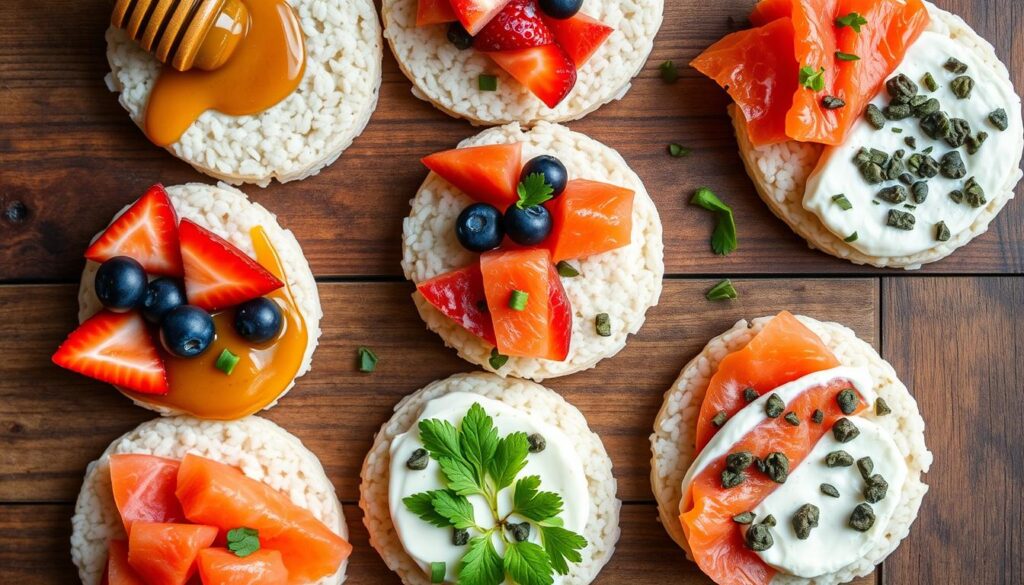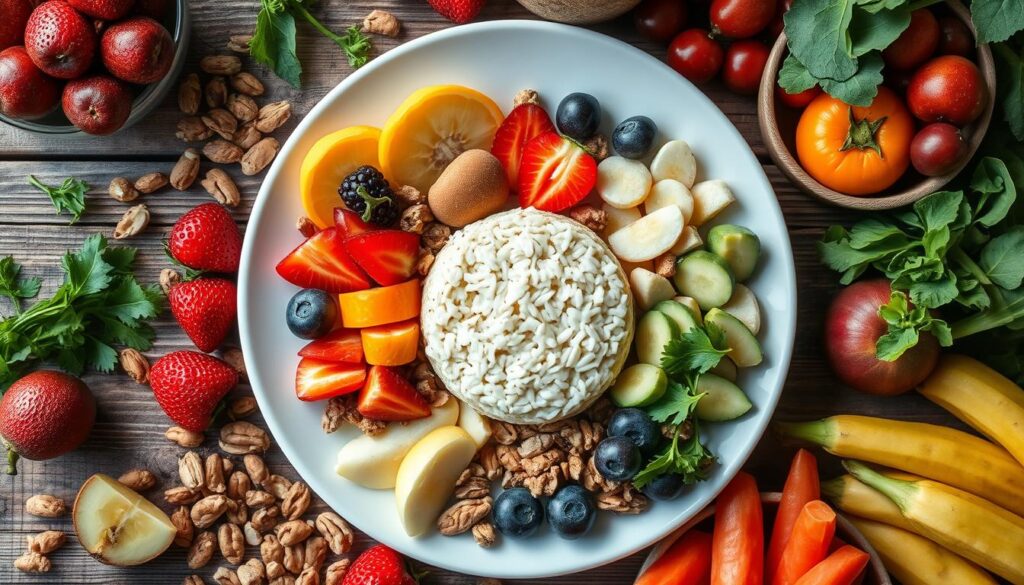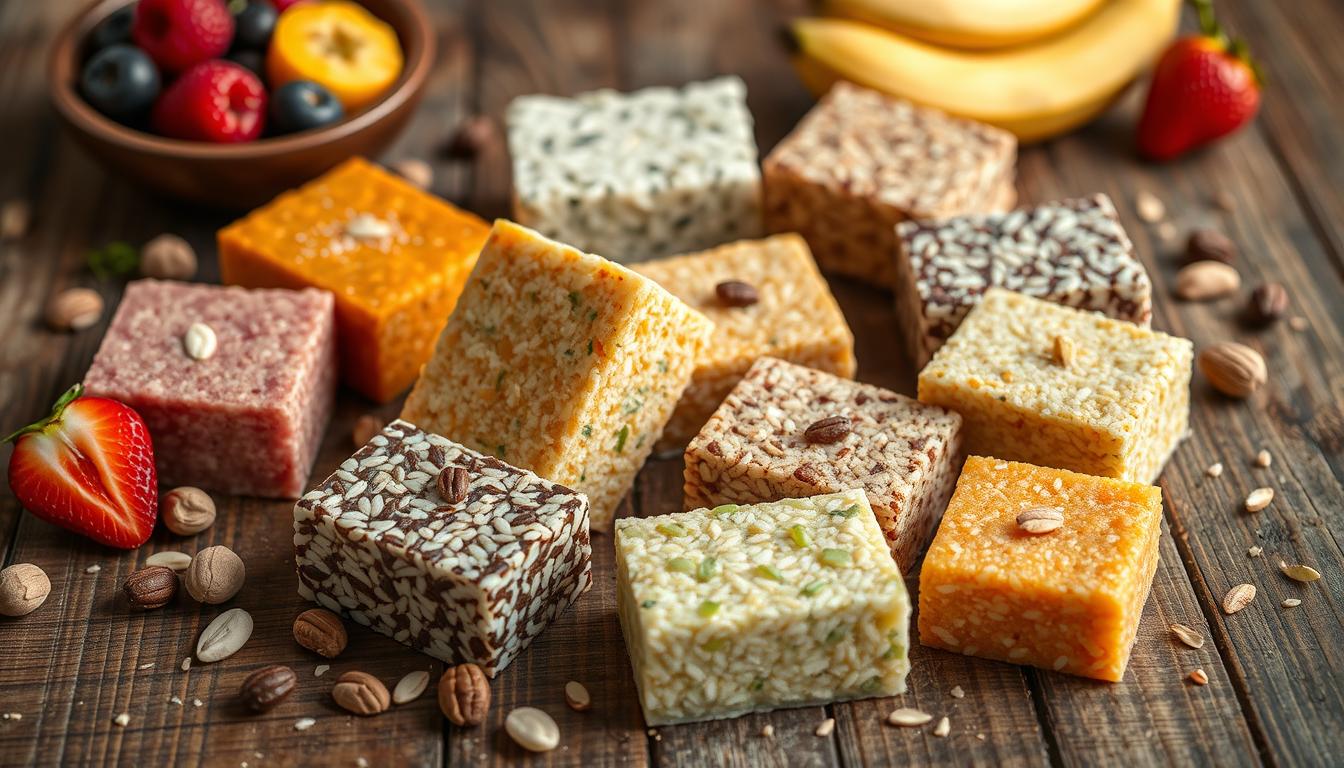Ever craved a snack that’s healthy but still satisfying? Rice cakes are your answer. These crunchy, versatile snacks are a great alternative to traditional treats. They’re low in calories but packed with nutrition.
Finding snacks that are both healthy and tasty can be tough. Rice cakes make it easy. They’re low in calories and can be topped with almost anything. This makes them a guilt-free way to satisfy your cravings while staying healthy.
Understanding Rice Cakes: A Modern Healthy Snack Alternative
Rice cakes are a favorite snack for those who want something healthier than bread, crackers, and chips. They are light and airy, with a unique texture and nutritional benefits.
What Makes Rice Cakes Different from Traditional Snacks
Rice cakes are special because of how they’re made. Unlike other snacks, they’re made by heating and pressing grains. This makes them a low-calorie option, often with fewer carbs than bread and crackers.
For example, a 9-gram brown rice cake has 35 calories and 7 grams of carbs. In contrast, a 9-gram slice of white bread has 24 calories and 4.4 grams of carbs.
The Manufacturing Process Behind Rice Cakes
Making rice cakes is a unique process. First, rice grains are heated and pressed in a hot cylinder. This makes them burst and expand, creating their airy texture.
Types of Rice Used in Production
Rice cakes can be made from different types of rice, like white or brown. The type of rice used affects the cake’s nutritional value and taste. Brown rice cakes, for example, have more fiber and nutrients than white rice cakes.
“Rice cakes differ from Asian rice cakes, which tend to be more chewy and dense rather than crispy as in the U.S.”
Rice cakes in the U.S. are crisp and airy, unlike Asian rice cakes which are chewier. This makes American rice cakes a unique snack choice.
Rice cakes are a modern, healthy snack option. They meet the demand for low-calorie, low-carb snacks among health-conscious people.
The Nutritional Profile of Rice Cakes
Rice cakes have a simple nutritional profile. A plain, unsalted rice cake has about 35 calories. It has 0 grams of fat, 2 milligrams of sodium, and 7 grams of carbs. It also has 0 grams of fiber, sugar, and protein.
Even though rice cakes aren’t packed with nutrients, they do offer some essential minerals. A single rice cake gives you about 3% of the daily magnesium, 4% of phosphorus, 3% of zinc, and 3% of selenium.
The nutritional values can change based on the flavor or type of rice cakes. Some may have added sugars or other ingredients that affect calories and nutrients. Still, rice cakes are low in calories and nutrients, making them great for adding healthy toppings.
| Nutrient | Amount per 1 Rice Cake (9g) | % Daily Value* |
|---|---|---|
| Calories | 40 | 2% |
| Total Fat | 0g | 0% |
| Sodium | 15mg | 1% |
| Total Carbohydrates | 8g | 3% |
| Dietary Fiber | 0g | 0% |
| Sugars | 0g | 0% |
| Protein | 0.5g | 1% |
| Iron | 0.10mg | 1% |
Rice cakes are a low-calorie, low-nutrient snack. But, they’re great for adding healthy toppings. This makes them a good choice for a balanced snack.
Why Rice Cakes Are Your Perfect Weight Management Companion
If you’re trying to manage your weight, rice cakes are a great snack. They are low in calories but fill you up, helping you eat less. This is key for losing weight.
Low-Energy Density Benefits
Studies show eating foods with less energy can lead to weight loss. Rice cakes have about 30-35 calories each. This makes them a good choice for those watching their calories.
Portion Control Made Easy
Rice cakes are already the right size, making it easy to control your portions. Unlike other snacks, they help you stay on track with your calorie goals.
Calorie-Conscious Snacking
Snacking can be tricky when you’re trying to lose weight. But rice cakes are a low-calorie option that can curb your cravings. Try them with avocado or hummus for a nutritious and filling snack.
“Incorporating rice cakes into your diet can be a game-changer for weight management. Their low-calorie, pre-portioned nature makes them an ideal snack choice to support your health and fitness goals.”
Versatile Topping Ideas for Sweet and Savory Cravings
Rice cakes are great for both sweet and savory toppings. You can make them with classic combos like peanut butter and banana or try fancy ones like avocado and everything bagel seasoning. There are endless options to make your rice cakes delicious.
For a protein-rich snack, try hummus and veggies like cucumbers, bell peppers, or cherry tomatoes on rice cakes. The creamy hummus and crunchy veggies make a tasty mix. You can also go for cream cheese and smoked salmon for a fancy rice cake.
For something sweet, spread nut butter and add bananas or honey. For a richer treat, melt dark chocolate and sprinkle sea salt. Or, try ricotta cheese with strawberries or Greek yogurt with chia seeds.
For a summer vibe, top rice cakes with tuna or chicken salad. These protein-rich toppings are light and flavorful. Add pomegranate seeds or lemon zest for a fresh twist.
Rice cakes are a healthy snack that you can make your own. Try different toppings to find your favorites. This way, you can satisfy all your cravings.

Rice Cakes for Special Dietary Needs
Rice cakes are great for many diets. They are gluten-free and vegan-friendly. This makes them perfect for people with certain dietary needs or preferences.
Gluten-Free Benefits
People with celiac disease or gluten sensitivity love rice cakes. They don’t have gluten, so they’re safe to eat. With 3 million Americans having celiac disease, gluten-free snacks like rice cakes are in high demand.
Vegan and Vegetarian Friendly Options
Rice cakes are also great for vegan and vegetarian diets. They don’t have animal products, fitting well with plant-based diets. As the vegan food market grows, snacks like rice cakes become more important.
FODMAP Considerations
For those on a FODMAP diet, rice cakes are a good choice. They are low in FODMAPs, making them easy to digest. With 10-15% of the world’s population having IBS, low FODMAP foods are in high demand.
Rice cakes are a versatile snack for many diets. They are gluten-free, vegan, and low FODMAP. Knowing their benefits helps you make healthy choices for your diet.
The Role of Rice Cakes in a Balanced Diet
Rice cakes, especially those made with brown rice, are good for a balanced diet. Brown rice is full of whole grains. Studies show these grains can lower the risk of obesity, heart disease, and some cancers. Brown rice also has antioxidants and helps protect the heart.
But, remember to eat rice cakes with other foods like protein, healthy fats, and fiber. This mix ensures you get all the nutrients you need for good health and feeling full.
- A medium-sized rice cake has about 40 calories, 8 grams of carbs, and less than 1 gram of protein and fat.
- Rice cakes have a low glycemic index. This means they don’t raise blood sugar quickly. They’re good for managing weight and health.
- Flavored rice cakes might have more sodium and calories. Always check the labels for the least amount of additives.
- Whole grain rice cakes are healthier than processed ones. They’re a better choice for snacks.
Eating rice cakes as part of a diet full of whole foods is beneficial. It lets you enjoy the health benefits of whole grains while keeping your diet balanced and satisfying.
| Nutrient | Amount per Medium Rice Cake |
|---|---|
| Calories | Approx. 40 kcal |
| Carbohydrates | 8 grams |
| Protein | Less than 1 gram |
| Fat | Less than 0.6 grams |
| Fiber | 0.3 grams |

“A balanced diet that includes whole grains like brown rice cakes can contribute to overall health and wellness.”
Smart Shopping Guide: Choosing the Best Rice Cakes
Rice cakes are a great choice for healthy snacking. But, with so many options, it can be hard to choose. Knowing what to look for helps you pick the best rice cakes for you.
Reading Labels Effectively
Start by reading the labels on rice cakes. Look for ones with just rice and salt. Avoid flavored ones, as they might have added sugars or other unhealthy ingredients.
Popular Brands and Varieties
Well-known brands like Quaker, Lundberg, and Ceres Organic offer great rice cakes. Quaker has many flavors for different tastes. Lundberg focuses on organic and whole grain options. Ceres Organic makes clean, simple rice cakes.
Think about your dietary needs, taste, and health goals when picking rice cakes. Reading labels and knowing about popular brands helps you make good choices for a healthy lifestyle.
| Brand | Variety | Ingredients | Dietary Suitability |
|---|---|---|---|
| Quaker | Caramel Apple | Brown rice, cane sugar, natural flavors | Gluten-free, vegetarian |
| Lundberg | Organic Brown Rice Cakes | Organic whole grain brown rice | Gluten-free, vegan, non-GMO |
| Ceres Organic | Original Rice Cakes | Organic brown rice, sea salt | Gluten-free, vegan, non-GMO |
By carefully reading labels and understanding the different rice cake options, you can make smart and healthy choices that align with your dietary preferences and nutritional goals.
Health Benefits and Potential Considerations
Rice cakes are a great snack because they’re low in calories and gluten-free. They’re good for people with celiac disease or gluten sensitivity. But, there are some things to think about.
Rice cakes are easy to digest. They’re made from simple ingredients, so most people can eat them without trouble. This is great for those who can’t eat gluten.
However, rice cakes have a high glycemic index. This can make blood sugar levels go up fast. To avoid this, eat them with protein, fiber, or healthy fats like nut butters or avocado. This helps keep blood sugar stable.
Rice cakes aren’t very filling on their own. But, they can be part of a healthy meal or snack when topped with good stuff. They’re a good choice for a balanced diet because they’re easy to use in many recipes.
“Rice cakes offer a healthy, gluten-free alternative to traditional snacks, but it’s important to be mindful of their glycemic impact and pair them with other nutritious ingredients.”
In short, rice cakes have many health benefits. They’re low in calories, gluten-free, and easy to digest. But, their high glycemic index is something to watch out for. Pairing them with protein, fiber, or healthy fats can help manage blood sugar and support digestion.
Creative Ways to Incorporate Rice Cakes Into Your Meal Plan
Rice cakes are a great snack that’s easy to add to your meals. They can make your dishes crunchy or turn into a tasty treat. Use them for open-faced sandwiches, salads, or as a dip substitute.
For breakfast, try cottage cheese and fruit on rice cakes. Or, make a healthier avocado toast on them. For dessert, spread nut butter and dark chocolate for a sweet treat that’s still healthy.
This article shows how versatile rice cakes can be. Try new flavors and toppings to meet your healthy snack ideas. Make rice cakes a key part of your balanced diet.

